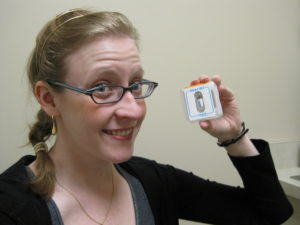For most of my life, I’ve had digestive problems of varying severity. Back in February, this manifested as an extended, painful bout that lasted weeks at a time, recurred every few weeks, and began to lead to malnourishment (and, counterintuitively, skyrocketing iron levels).
After running a battery of tests, blood and otherwise, it was decided that I needed a colonoscopy, which occurred in May. The blood tests ruled out conditions like celiac, which was a relief. But we couldn’t rule out cancer since colon cancer has occurred in my family tree — that was a scary wait. I won’t varnish the truth – the day before a colonoscopy is terrible. Liquid-only diet, laxative prep so salty my body tried to insist it was poison… DISLIKE. But it’s also important – I have a coworker who managed to survive Stage IV colon cancer, but the 5 year survival rate on that is 10%, so she is blessed indeed. And her diet is forever changed – these sorts of things need to be caught early.
Mercifully, there was no colon cancer. But my doctor still thought there might be something wrong: though I’m known to have hemachromatosis, my iron levels shot up higher than normal for me over the spring; and last year I was diagnosed with B12 anemia and had to inject myself with B vitamins till we caught up. Both of these issues suggested there COULD be a problem with my small intestine. But to see the small intestine, historically the only option was an endoscopy – sticking a cord down your throat; highly invasive.
Thank goodness my gastroenterologist is living in The Future(TM). She prescribed a capsule endoscopy: instead of a corded camera, you swallow a pill-sized Bluetooth camera with embedded flash capable of taking 8 hours of video while making its trip through your digestive system. The associated equipment is expensive enough that my doctor’s office only has 2 sets, and they only perform the test on Monday mornings – 2 per day. So only 8 people in an average month, sometimes less, can have the procedure. I waited about 6 weeks for my scheduled appointment. It was strange to inform my coworkers that I’d “be working from home Monday because I have to swallow a camera for science.”
As it turns out, the concept of a camera documenting my digestive system is massively fascinating to friends. I had no less than a dozen requests for the video, as well as countless excited questions. (And one friend who posted to my Facebook wall recruiting for shady adventurers to man the pill crew.) So for those wondering what the test actually involves, here’s an overview.

Prep begins after lunch the day before the procedure, when you switch to a clear liquid diet. In the end, you’re fasting for the capsule endoscopy for about 24 hours and then a small meal for the next 4-6. My colonoscopy, on the other hand, required about 36 hours of fasting. Advantage: endoscopy.
At 4 PM, you drink a bottle of Magnesium Citrate (about 10 oz). When I went to the drugstore to pick this solution up, I was struck by several things:
- Magnesium Citrate costs $1.50. The prep kit for my colonoscopy ran around $60 – $80 to insurance.
- The store-brand (only choice) bottle billed itself as “The Sparkling Laxative”. It just seems a misplaced adjective, as if they think they’re the Champagne of Laxatives. (Though compared to MoviPrep for colonoscopies, it IS a little bit like champagne.)
- There were two flavor choices: “Cherry” and “Pleasant Lemony Flavor”. This felt like a trap. Why is “Lemony” pleasant? Is Cherry UNpleasant? Or is lemon so bad that they have to bump up the sales pitch with “Pleasant” and a bonus “y” in there for good measure? Regardless, I chose “Lemony” – because the cherry stuff was red, and anyone who has done digestive imaging knows that Red==Blood and is thus verboten.
I won’t regale you with the tale of the rest of the events post-laxative, but the only other salient piece of information is that after 10PM it’s no liquid or food until lunchtime the next day.

Fast forward to the morning of the “procedure”. I showed up at the doctor’s office at 7:30 AM and was taken to an exam room where I signed another consent form. The PillCam was brought out in a plastic case and the serial number recorded, which gave me a few minutes to document the situation. (Please forgive my bedraggled appearance – you’d be rather run down too at 7:30AM after 24 hours of fasting and not much sleep!)
Once the nurse who is in charge of the capsule endoscopies showed up, they hooked me up. A wide antenna belt is wrapped tightly around your waist and lower ribcage. There is a covered cable that runs from the antenna to a receiver device, which is worn in a purse across your body from one shoulder to the opposite hip. (It’s worn this way to minimize bumping of the receiver.)
The receiver itself is the size of a paperback book. It appears to contain a standard hard drive, since it vibrated a couple of times when receiving photos. It has three lights – one green power light, an orange light for hard drive writes, and a blue light that links when it receives transmissions from the capsule.
Then the moment of truth arrived. The PillCam itself arrives ensconced in a plastic box. It is half opaque, and half transparent. It’s the size of a rather large vitamin. When removed from the box, there’s a magnet in the box that alerts the PillCam to turn itself on – so no taking it out early. You can tell the PillCam is on because the flash engages – three flashes every second as long as the pill battery is alive.
You’re given a small glass of water with some anti-gas drops — apparently gas shows up on camera as overly shiny reflective pockets that ruin shots. It was stranger than I thought to get my head around swallowing the pill because it was flashing – my brain tried to tell me it was a small fairy and thus not food. But once you get past that, the swallowing itself was anticlimactic. It went down on the first try, and I didn’t feel anything afterwards.

From that moment on, you’re free to go about your day – except no jostling the receiver, no bending over, no sweating, and no eating except for a half-lunch at the prescribed hour. So I worked from home. Besides, that saved me the 2,000 conversations I would have had explaining the equipment I was hooked up to. It’s not subtle. I also took the opportunity to photograph myself modeling the equipment for my curious friends. If this “Microsoft” thing doesn’t work out, I can always pursue an inevitably lucrative career in medical device modeling, right?
They also give you a take-home sheet that also serves as a diary; they need you to write down everything you eat or drink with times, as well as any other notes, like unexpected strenuous activity. You are also told to monitor the receiver – it should be blinking blue several times a second to indicate receiving pictures, and if it turns yellow prematurely the pill might be stuck. The sheet also helpfully reminds you that PillCam is metal, and if you go anywhere near an MRI you are going to be super sorry. (It’s not on the sheet, but I assume you should also avoid Magneto. But as the Iron Maiden, *I* always do. It’s just good policy.)
For the record, working from home actually made me mildly nervous for a moment – the camera was Bluetooth, and my laptop’s Bluetooth seems to turn itself back on like a haunted lightswitch. I worried my laptop might pair with the camera unbidden, throwing the test into chaos. Mercifully, this was not an issue. I imagine the giant antenna belt, plus the fact that the camera was INSIDE MY BODY, provided enough interference even if it might have been an issue…
Exactly eight hours after swallowing the pill, you return to the doctor’s office. They tell you PillCam has an exactly 8-hour battery, and they’re not kidding: I got there a few minutes early and had to wait in the waiting room briefly until the light went from blue to yellow, indicating the pill is done with its work. They take your diary sheet, and rapidly disconnect you from the devices – and you’re done! Free to eat again, so I ordered a pizza.
There is no early diagnosis – it takes 25 minutes just to download the footage by Firewire, and then a lab tech has to painstakingly step through EVERY IMAGE to make sure nothing is missed. In my case, I received a letter from the office on Thursday (the test was Monday) – apparently my small intestine is…. COMPLETELY NORMAL. Nothing in my body is completely normal! Shock and awe! Sadly, they did not send me a disc with the footage, so YouTube will have to wait.
For me, this is the dreaded line of no return – at this point, we’re out of tests and my entire digestive system LOOKS fine. I suppose I should take heart that we’ve confirmed I HAVE a digestive system (hey, with me you never know) and that it is normal. I’m also thankful that my doctor took my complaints seriously enough to investigate them at this level, since I have friends with REAL problems (like Crohn’s, which is what we feared for me) who have not been as lucky.
But for friends who may be looking to diagnose a problem with their small intestines, ask your doctor. I know that my doctor uncle had never seen this in action – I think it’s not widespread yet and you might need a referral. It’s the most fun I’ve had getting medical answers, though – for a girl whose treatments have involved bloodlettings and what appeared to be drywall screws in my knee, I appreciated my brief Fantastic Voyage into the future promise of medicine.
PS – I won’t go into details, but I’m certain that the PillCam’s epic journey through my body is forever completed. And no, you don’t have to give it back. Thank God.
PPS – I almost wanted to add the “Girls in Technology” category to this post, until I realized I’d have to change it to be “Technology in Girls”. BA DUM BUM. Also, courtesy of a Facebook friend: “Cheryl is now officially an electronics consumer.” The humor, it goes on for days!
1 thought on “My Fantastic Voyage”
Comments are closed.